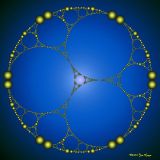|
Suggested order of reading:
1A. "A Theorem..." Shows the correspondence of disks (circles) and the Minkowski space.
Terms "co-curvature",
"reduced coordinates, "circle symbols" are introduced.
Descartes theorem is a special case of the theorem proved here.
1B. "Proof..." is a succinct version of the above.
The rest are various applications.
Except for "On Diophantine... which stands alone.
"Apollonian Window" was named so in "Clifford..." in the other column.
Fibonacci numbers and Ford circles
(8 pages, arXiv:2003.00852)
An amusing connection between Ford circles, Fibonacci numbers, and golden ratio is shown.
Namely,
certain tangency points of Ford circles are concyclic and involve Fibonacci numbers.
They form four circles that cut the x-axis at points related to the golden ratio.
Apollonian depth and the accidental fractal
(35 pages, arXiv:2002.04135)
The depth function of three numbers representing curvatures of three mutually tangent circles is introduced.
Its 2D plot leads to a partition of the moduli space of the triples of mutually tangent circles/disks
that is unexpectedly a beautiful fractal, the general form of which resembles that of an Apollonian disk packing,
except that it consists of ellipses instead of circles.
A note on unbounded Apollonian disk packings
(10 pages, arXiv:1910.05924)
A construction and algebraic characterization of two unbounded Apollonian
Disk packings in the plane and the half-plane are presented. Both turn out to
involve the golden ratio.
On the Dedekind tessellation
(16 pages, arXiv:1912.05768)
The Dedekind tessellation is usually viewed as a system of ideal triangles
obtained through the action of
PSL(2,\(\mathbb Z)\) in the upper half-plane.
But here it is viewed it rather as a system of circles and give their complete
characterization with the help of the Lorentz group acting in the Minkowski space of circles.
Interesting interplay of geometry, group theory and number theory.
Plus a simple algorithm for drawing the Dedekind tessellation.
Plus Fibonacci numbers.
Skein relations for spin networks, modified,
Journal of Knot Theory and Its Ramifications 27 (7) 2018
(21 pages, arXiv:1807.07244)
Although the main matter is a skein relation for spin networks, the last sections consider
Apollonian disk packings as a source of spin networks.
The Koide Lepton Mass Formula and Geometry of Circle Configurations
(3 pages, arXiv:1201.2067)
A remarkable formal similarity between Koide's Lepton mass formula
and a generalized Descartes circle formula is reported.
Also, a similar formula for quarks is proposed.
⛋
Proof of Descartes circle formula and its generalization clarified
( arXiv:1910.09174).
A succict, to-the-point, version of the derivation of the (generalized) Descartes circle theorem,
first presented in the paper below.
⛋
A theorem on circle configurations
(arXiv:0706.0372).
A generalization of the Descartes circle theorem to quite arbitrary configurations.
The correspondence between circles in a plane and vectors in Minkowski space is utilized.
The "extended Descartes theorem" in "Beyond the Descartes theorem" by Lagarias at al.
(see below in Readings) is a special case for circles that are tangent.
Lens sequences
(33 pages, arXiv:0710.3226).
About sequences of curvatures of chains of circles inscribed
in lenses, i.e., intersections of two overlapping disks of the same radius.
Lots of intriguing properties.
Such lens sequences appear in the Apollonian Window.
Golden ratio and Fibonacci and Lucas numbers appear through them.
On a Diophantine equation that generates all integral Apollonian disk packings
ISNR Geometry, 17 2007 pp. 71-93.
A simple purely geometric derivation of the Diophantine equation and algorithm to
generate all integral Apollonian packings. Includes some remarks on Pythagorean triples
occurring in the packings.

|
Golden window
(Mathematics Magazine, 83 Dec 2010, pp. 384-90).
A very light text about a window built with design that conceals the golden ratio
and its various powers. The cover features a figure based on this article.
|
|
|
Suggested order of reading: Start at the bottom and read upward.
1. "Clifford..." introduces the idea of tangency spinor (without the term "tangency").
2. "Spinors..." contains the key theorems on the tangency spinors.
Does not require reading 1.
3A. "Apollonian coronas..." and 3B. "Tessellations..." are parallel and use the facts proved in 2.
They also contain a short account of 2.
Spinors, lattices, and classification of integral Apollonian disk packings.
(35 pages, arXiv:2001.05866)
Two integral tangency spinors (2-vectors)
are shown to define integral Descartes configuration,
and an integral Apolloian disk packing.
Supprizingly, the result
may be restated in terms of the Pauli spinors.
Other keywords: celestial sphere, hyperbolic plane, Hopf fibration,
Tessellations and Descartes disk configurations
(12 pages, arXiv:1910.05919)
An intriguing correspondence between certain finite planar tessellations and
the Descartes circle arrangements is presented. This correspondence may be
viewed as a visualization of the spinor structure underlying Descartes circles.
Apollonian coronas and a new zeta function
(19 pages, arXiv:1909.09941)
A formula for the area of disks tangent to a given disk in an Apollonian disk packing (corona)
in terms of a certain novel arithmetic Zeta function is found.
The idea is based on "tangency spinors" defined for pairs of tangent disks.
⛋
Spinors and the Descartes configuration of circles
,
(21 pages, arXiv:1909.06994)
Tangency spinors are defined for pairs of tangent disks in the Euclidean plane.
A number of theorems are proved,
one of which may be interpreted as a "square root of Descartes Theorem".
In any Apollonian disk packing, spinors form a network.
In the Apollonian Window, a special case of Apollonian disk packing, all spinors are integral.
⛋
Clifford Algebras and Euclid's parameterization of Pythagorean Triples
Advances in Applied Clifford Algebras (Mathematical Structures), 17 2007 pp. 71-93).
Why Euclid's parameters of pythagorean triples are "spinors".
You may find here also formulas for parameterization of Pythagorean
quadruples, hexads and decuples (using quaternions and octonions)
as well as a geometric interpretation of Hall matrices in the context of
the Apollonian Window.
|
![]()
![]()
![]()








